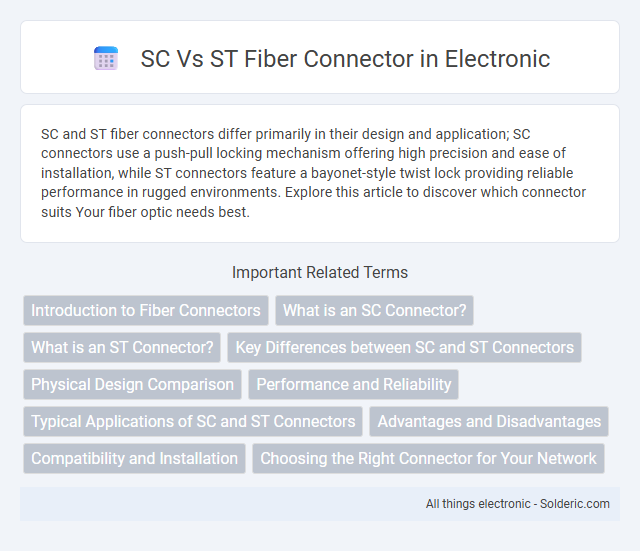SC and ST fiber connectors differ primarily in their design and application; SC connectors use a push-pull locking mechanism offering high precision and ease of installation, while ST connectors feature a bayonet-style twist lock providing reliable performance in rugged environments. Explore this article to discover which connector suits Your fiber optic needs best.
Comparison Table
| Feature | SC Fiber Connector | ST Fiber Connector |
|---|---|---|
| Connector Type | Push-pull snap-in | Bayonet twist-lock |
| Shape | Rectangular | Cylindrical |
| Installation | Easy, quick plug-and-play | Requires twist and lock |
| Use Case | Data center, telecom, LAN | Legacy networks, campus LAN |
| Insertion Loss | Typically 0.25 dB | Typically 0.3 dB |
| Durability | High mechanical durability | Moderate durability |
| Compatibility | Widely used in modern systems | Common in older systems |
| Ferrule Diameter | 2.5 mm | 2.5 mm |
Introduction to Fiber Connectors
SC fiber connectors feature a push-pull coupling mechanism and are widely used for their low insertion loss and high reliability in data communication networks. ST fiber connectors utilize a bayonet-style twist lock, providing secure connections ideal for legacy multimode fiber applications in campus networks. Both SC and ST connectors serve as standardized interfaces for terminating optical fibers, ensuring efficient signal transmission and minimizing optical loss.
What is an SC Connector?
An SC connector is a push-pull fiber optic connector commonly used in telecommunications and data networks for its reliable, snap-in coupling mechanism. This connector features a square-shaped housing and provides low insertion loss and high return loss, making it ideal for high-performance fiber optic applications. You can easily install SC connectors in both single-mode and multimode fiber cables, ensuring efficient and secure connections in various networking environments.
What is an ST Connector?
An ST (Straight Tip) fiber connector features a bayonet-style coupling mechanism and is widely used in multimode fiber optic networks for reliable and quick connections. It has a cylindrical ferrule made of ceramic or metal that aligns the fiber precisely, minimizing signal loss and back reflection. The ST connector is favored in legacy network installations and environments requiring durable, twist-lock connections.
Key Differences between SC and ST Connectors
SC and ST fiber connectors differ primarily in their coupling mechanisms: SC connectors feature a push-pull locking system, enabling quick and secure connections, while ST connectors use a twist-on bayonet-style locking system for reliable fiber alignment. SC connectors have a square shape with a snap-in design, making them ideal for high-density installations, whereas ST connectors possess a cylindrical shape suited for legacy network setups. Your choice between SC and ST fiber connectors should consider compatibility with existing hardware and the specific demands of your network environment.
Physical Design Comparison
SC fiber connectors feature a square, push-pull design that allows easy insertion and removal, while ST connectors have a round, bayonet-style twist lock mechanism ensuring secure attachment. SC connectors typically offer a more compact and robust housing, making them suitable for high-density applications, whereas ST connectors are bulkier but favored in legacy network systems. Your choice between SC and ST connectors will depend on the requirements for space efficiency and connection stability in your fiber optic setup.
Performance and Reliability
SC fiber connectors deliver high performance with low insertion loss typically around 0.2-0.5 dB, ensuring reliable signal transmission in various network environments. ST connectors also provide dependable connections but exhibit slightly higher insertion loss, usually around 0.3-0.7 dB, which may affect performance in long-distance or high-speed applications. Your choice between SC and ST connectors should consider the specific network requirements, including durability and ease of maintenance, where SC connectors often offer superior reliability due to their push-pull coupling design.
Typical Applications of SC and ST Connectors
SC connectors are commonly used in high-density network environments such as data centers, telecom infrastructure, and fiber optic LANs due to their push-pull design that enables easy insertion and removal. ST connectors find typical applications in legacy network systems, campus networks, and industrial settings where the bayonet-style coupling provides a secure and reliable connection, especially for multimode fiber. Understanding the specific application of your fiber optic network helps determine whether SC or ST connectors best meet performance and compatibility requirements.
Advantages and Disadvantages
SC fiber connectors offer advantages such as easy push-pull coupling for quick installation and a robust ferrule design that ensures low insertion loss and high repeatability. However, their square shape can limit density in high-port-count panels compared to ST connectors. ST fiber connectors provide secure bayonet locking and excellent durability in harsh environments but tend to have higher insertion loss and are bulkier, making them less suitable for space-constrained applications.
Compatibility and Installation
SC fiber connectors feature a push-pull locking mechanism ensuring easy and quick installation with high compatibility in single-mode and multi-mode fiber networks. ST fiber connectors utilize a bayonet-style twist lock, providing secure connections primarily in legacy multi-mode systems but may require more precise alignment during installation. Your choice depends on the existing infrastructure and the desired ease of maintenance and compatibility with fiber optic equipment.
Choosing the Right Connector for Your Network
Selecting the right fiber connector, such as SC or ST, depends on factors like network environment, ease of installation, and performance requirements. SC connectors offer a push-pull coupling mechanism suitable for high-density applications and provide low insertion loss, while ST connectors use a bayonet-style twist lock ideal for legacy networks and environments requiring quick connections. Evaluating connector compatibility with existing infrastructure and anticipated signal integrity ensures optimal network reliability and efficiency.
SC vs ST fiber connector Infographic

 solderic.com
solderic.com